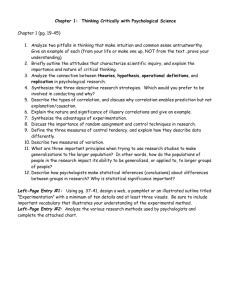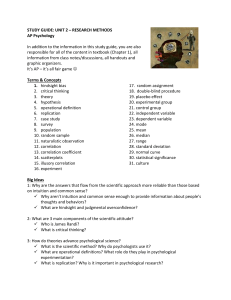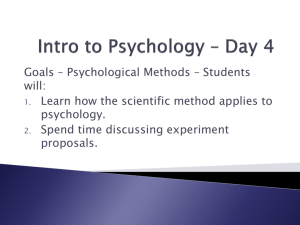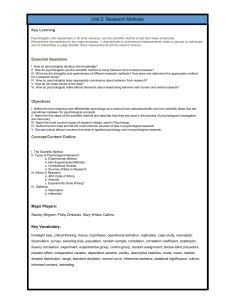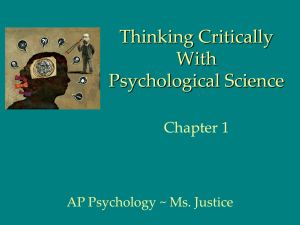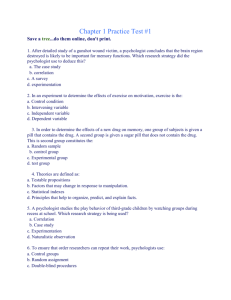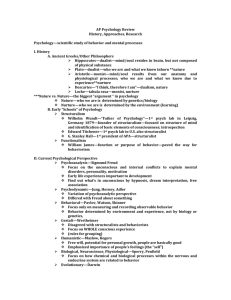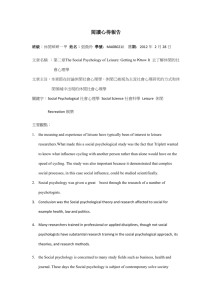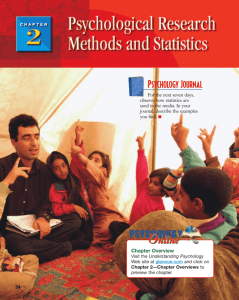Objective 1 | Describe hindsight bias, and explain how it can make
advertisement
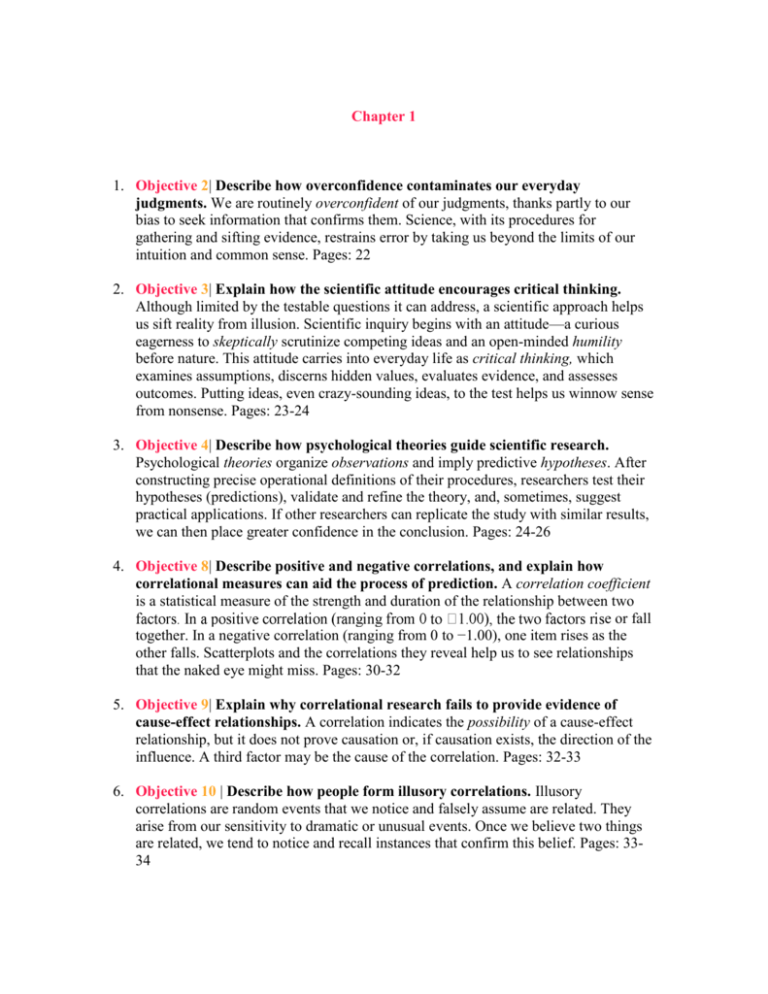
Chapter 1 1. Objective 2| Describe how overconfidence contaminates our everyday judgments. We are routinely overconfident of our judgments, thanks partly to our bias to seek information that confirms them. Science, with its procedures for gathering and sifting evidence, restrains error by taking us beyond the limits of our intuition and common sense. Pages: 22 2. Objective 3| Explain how the scientific attitude encourages critical thinking. Although limited by the testable questions it can address, a scientific approach helps us sift reality from illusion. Scientific inquiry begins with an attitude—a curious eagerness to skeptically scrutinize competing ideas and an open-minded humility before nature. This attitude carries into everyday life as critical thinking, which examines assumptions, discerns hidden values, evaluates evidence, and assesses outcomes. Putting ideas, even crazy-sounding ideas, to the test helps us winnow sense from nonsense. Pages: 23-24 3. Objective 4| Describe how psychological theories guide scientific research. Psychological theories organize observations and imply predictive hypotheses. After constructing precise operational definitions of their procedures, researchers test their hypotheses (predictions), validate and refine the theory, and, sometimes, suggest practical applications. If other researchers can replicate the study with similar results, we can then place greater confidence in the conclusion. Pages: 24-26 4. Objective 8| Describe positive and negative correlations, and explain how correlational measures can aid the process of prediction. A correlation coefficient is a statistical measure of the strength and duration of the relationship between two e or fall together. In a negative correlation (ranging from 0 to −1.00), one item rises as the other falls. Scatterplots and the correlations they reveal help us to see relationships that the naked eye might miss. Pages: 30-32 5. Objective 9| Explain why correlational research fails to provide evidence of cause-effect relationships. A correlation indicates the possibility of a cause-effect relationship, but it does not prove causation or, if causation exists, the direction of the influence. A third factor may be the cause of the correlation. Pages: 32-33 6. Objective 10 | Describe how people form illusory correlations. Illusory correlations are random events that we notice and falsely assume are related. They arise from our sensitivity to dramatic or unusual events. Once we believe two things are related, we tend to notice and recall instances that confirm this belief. Pages: 3334 7. Objective 11 | Explain the human tendency to perceive order in random sequences. We search for patterns in an attempt to make sense of the world around us. Patterns or sequences occur naturally in sets of random data, but we tend to interpret these patterns as meaningful connections. Pages: 34-35 8. Objective 12 | Explain how experiments help researchers isolate cause and effect. To discover cause-effect relationships, psychologists conduct experiments. By manipulating one or more factors of interest, and controlling other factors, experimenters can determine the effect on some behavior or mental process. Pages: 36-37 9. Objective 14| Explain the difference between an independent and a dependent variable. The independent variable is the factor you manipulate to study its effect. The dependent variable is the factor you measure to discover any changes that occur in response to these manipulations. Pages: 38-39 10. Objective 15 | Explain the importance of statistical principles, and give an example of their use in everyday life. Statistics help us to organize, summarize, and make inferences from data. We need not remember complicated formulas to think more clearly and critically about the data we encounter in everyday life. For example, understanding statistical concepts teaches us the importance of doubting big, round, undocumented numbers. Pages: 39-40 11. Objective 16| Explain how bar graphs can misrepresent data. Scale labels and ranges used in bar graphs can be designed to minimize or maximize differences. When looking at statistical graphs in books and magazines and on TV and the Internet, think critically. Pages: 40 12. Objective 17 | Describe the three measures of central tendency, and tell which is most affected by extreme scores. The median is the middle score in a group of data. The mode is the most frequently occurring score. The mean, the arithmetic average, is most easily distorted by a few very high or very low scores. Pages: 41 13. Objective 18| Describe two measures of variation. Measures of variation tell us how similar or diverse data are. A range describes the gap between the highest and lowest scores. The more useful measure, the standard deviation, states how much scores vary around the mean, or average, score. Pages: 41-42 14. Objective 19| Identify three principles for making generalizations from samples. 1. Representative samples are better than biased samples. 2. Less-variable observations are more reliable than those that are more variable. 3. More cases are better than fewer. Pages: 42-43 15. Objective 20| Explain how psychologists decide whether differences are meaningful. When averages from two samples are each reliable measures of their own populations, and the difference between them is relatively large, we can assume the difference is significant— that the result did not occur by chance alone. Statistical significance indicates the likelihood of a result’s occurring, not the importance of the result. Pages: 43-44 16. Objective 21| Explain the value of simplified laboratory conditions in discovering general principles of behavior. Researchers test theoretical principles by intentionally creating a controlled, simplified environment in the lab. Their concern is not the particular behavior being studied, but rather the underlying general principles that help explain many behaviors. Pages: 45 17. Objective 22| Discuss whether psychological research can be generalized across cultures and genders. Behaviors, ideas, attitudes, and traditions vary across cultures, but the principles that underlie them are shared, in part because of our common biological heritage. Biology also determines our sex, but our culture sets up expectations about what it means to be male or female. Males and females do differ in some ways, but they are biologically and psychologically much more alike than different. Pages: 45-46 18. Objective 23| Explain why psychologists study animals, and discuss the ethics of experimentation with both animals and humans. Some psychologists study animals out of an interest in animal behavior. Others do so because knowledge of the physiological and psychological processes of animals gives them a better understanding of the similar processes operating in humans. Under ethical and legal guidelines, animals used in psychological experiments rarely experience pain. Nevertheless, animal rights groups raise an important issue: Even if it leads to the relief of human suffering, is an animal’s temporary suffering justified? Occasionally researchers temporarily stress or deceive people to learn something important. Professional ethical standards provide guidelines concerning the treatment of research participants, and university ethics committees safeguard participants’ well-being. Pages: 46-47
